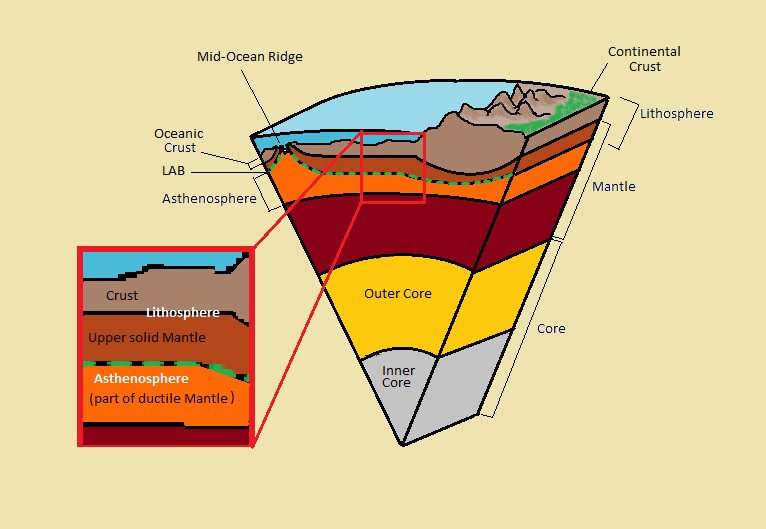
Embarking on a journey beneath the Earth’s surface unveils a realm of structural intricacies that define the very foundation of our planet. The Earth, a dynamic and ever-evolving celestial body, harbors a complex layering system that has captivated the curiosity of geographers and scientists alike. Delving into the depths of this geological wonder unveils a stratified composition comprising the crust, mantle, outer core, and inner core, each playing a distinct role in shaping the planet’s physical characteristics and influencing natural phenomena. This exploration into Earth’s layers serves as a gateway to understanding the forces that govern our planet’s dynamics, unraveling the mysteries concealed beneath its surface and offering insights into the delicate balance that sustains life on Earth.
Contents
Structure of the Earth Layered
- The earthquake waves change at definite intervals during their propagation through the interior of the earth. They also undergo the action of reflection and refraction.
- Places on Earth where seismic waves are not recorded are called “shadow zones”.
- P-waves, or primary waves, are the fastest seismic waves and can travel through solids, liquids, and gasses. S-waves, or secondary waves, are slower than P-waves and can only travel through solids.
- Both P-waves and S-waves change as they propagate through the Earth’s interior, and these changes can provide us with important information about the properties of the materials they are passing through.
- The shadow zone for S-waves is an area on the opposite side of the Earth from the earthquake epicenter, between 103 and 180 degrees. Because S-waves cannot travel through the Earth’s liquid outer core, which lies between the solid inner core and the mantle.
- The shadow zone for P-waves is an area between 103 and 142 degrees away from the epicenter. At these distances, P-waves encounter a boundary between the Earth’s outer core and mantle where their speed and direction are changed due to differences in density and composition.
- The interior of the earth is made up of several concentric layers of which the crust, the mantle, the outer core, and the inner core are significant because of their unique physical and chemical properties.
- The crust is a silicate solid, the mantle is a viscous molten rock, the outer core is a viscous liquid, and the inner core is a dense solid.
- Mechanically, the earth’s layers can be divided into lithosphere, asthenosphere, mesospheric mantle (part of the Earth’s mantle below the lithosphere and the asthenosphere), outer core, and inner core.
- Chemically, Earth can be divided into the crust, upper mantle, lower mantle, outer core, and inner core.
Structure of Lithosphere:
- The lithosphere is the rigid outer part of the Earth that includes the crust and the uppermost part of the mantle, with a thickness that varies between 10-200 km.
- It is divided into several large and small tectonic plates that are constantly moving due to the convection currents in the mantle.
- The average thickness of the lithosphere is about 70 km, but it can vary widely depending on the location. For example, the lithosphere can be very thin, only a few kilometers thick under the oceanic crust or mid-ocean ridges, while it can be very thick, 150+ km under continental crust, particularly mountain belts.
- The depth of the lithosphere typically ranges from 0-100 km.
- These movements can cause large-scale changes in the Earth’s geological structure such as the formation of mountains, rift valleys, and ocean basins, as well as earthquakes and volcanic eruptions.
- The source of heat that drives plate tectonics is the primordial heat left over from the planet’s formation, as well as the heat generated by the radioactive decay of uranium, thorium, and potassium in Earth’s crust and mantle.

Structure of Asthenosphere:
- The upper portion of the mantle, just below the lithosphere, is called the asthenosphere.
- It extends up to a depth of about 80-200 km and is characterized by its high viscosity, mechanical weakness, and ductility
- The density of the asthenosphere is higher than that of the crust, which is why it plays an important role in plate tectonic movements and isostatic adjustments.
- The ductility of the asthenosphere allows it to flow slowly over long periods, which helps to accommodate the movement of tectonic plates.
- The asthenosphere is also the main source of magma that finds its way to the surface during volcanic eruptions.

Structure of Hydrosphere
- The hydrosphere is the total amount of water on a planet, including all of the water that exists on the surface, underground, and in the atmosphere.
- This water can exist in different forms, including liquid, vapor, and ice.
- On Earth, the majority of the hydrosphere is made up of liquid water that exists on the surface in the form of oceans, lakes, rivers, and other bodies of water.
- The hydrosphere plays an important role in regulating the Earth’s climate and supporting life on the planet.
Frequently Asked Questions (FAQs)
Q1: What are the main layers of the Earth?
A1: The Earth is composed of three primary layers: the crust, mantle, and core. The crust is the outermost layer and is divided into the continental crust (which forms the continents) and the oceanic crust (beneath the oceans). Below the crust is the mantle, a semi-solid layer responsible for the movement of tectonic plates. The core, located at the Earth’s center, consists of an outer liquid layer and an inner solid layer, primarily composed of iron and nickel.
Q2: How do scientists study the Earth’s layers?
A2: Scientists study the Earth’s layers through various methods, including seismic studies, drilling, and satellite observations. Seismic waves generated by earthquakes provide valuable information about the composition and thickness of different layers. By analyzing how these waves travel through the Earth, scientists can create models of its internal structure. Additionally, drilling into the Earth’s crust provides direct samples for analysis. Satellites equipped with advanced sensors can measure gravitational variations, helping researchers understand density differences in the Earth’s layers.
Q3: What role do Earth’s layers play in plate tectonics?
A3: Earth’s layers play a crucial role in plate tectonics, the movement of the Earth’s lithospheric plates. The lithosphere, consisting of the crust and upper part of the mantle, is broken into several pieces called tectonic plates. These plates float on the semi-fluid asthenosphere beneath them. The heat generated by the radioactive decay of elements within the Earth’s interior causes convection currents in the mantle. These currents drive the movement of tectonic plates, leading to processes like subduction, where one plate slides beneath another, and the creation of new crust through volcanic activity at mid-ocean ridges. The interplay of Earth’s layers is fundamental to understanding the dynamic nature of our planet.
In case you still have your doubts, contact us on 9811333901.
For UPSC Prelims Resources, Click here
For Daily Updates and Study Material:
Join our Telegram Channel – Edukemy for IAS
- 1. Learn through Videos – here
- 2. Be Exam Ready by Practicing Daily MCQs – here
- 3. Daily Newsletter – Get all your Current Affairs Covered – here
- 4. Mains Answer Writing Practice – here
Visit our YouTube Channel – here

